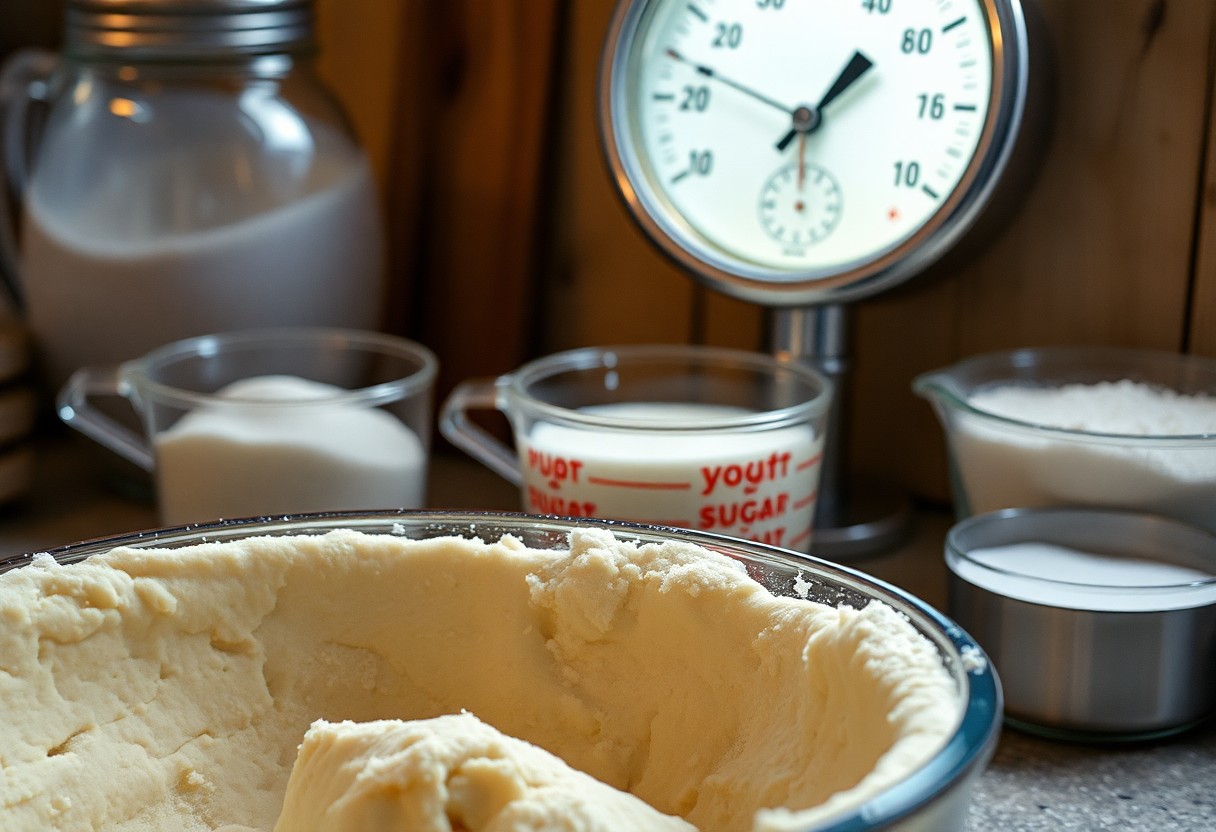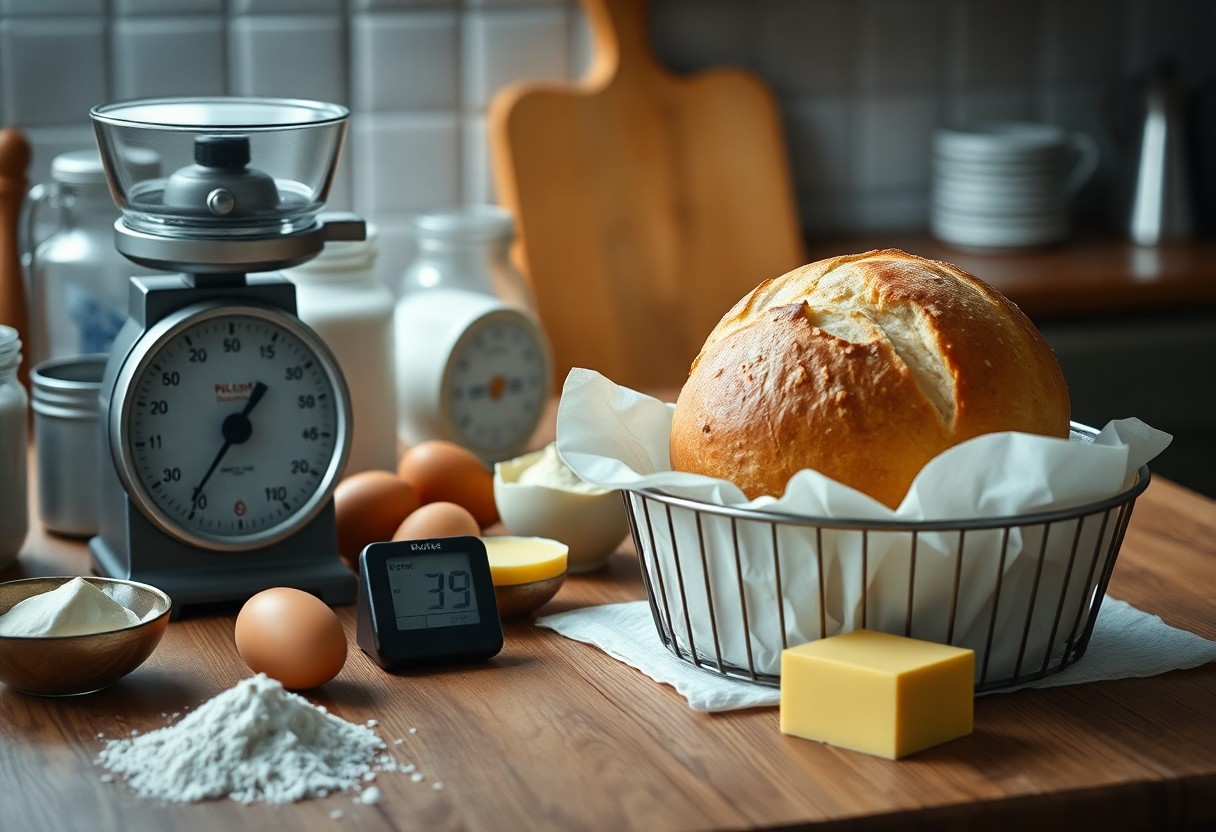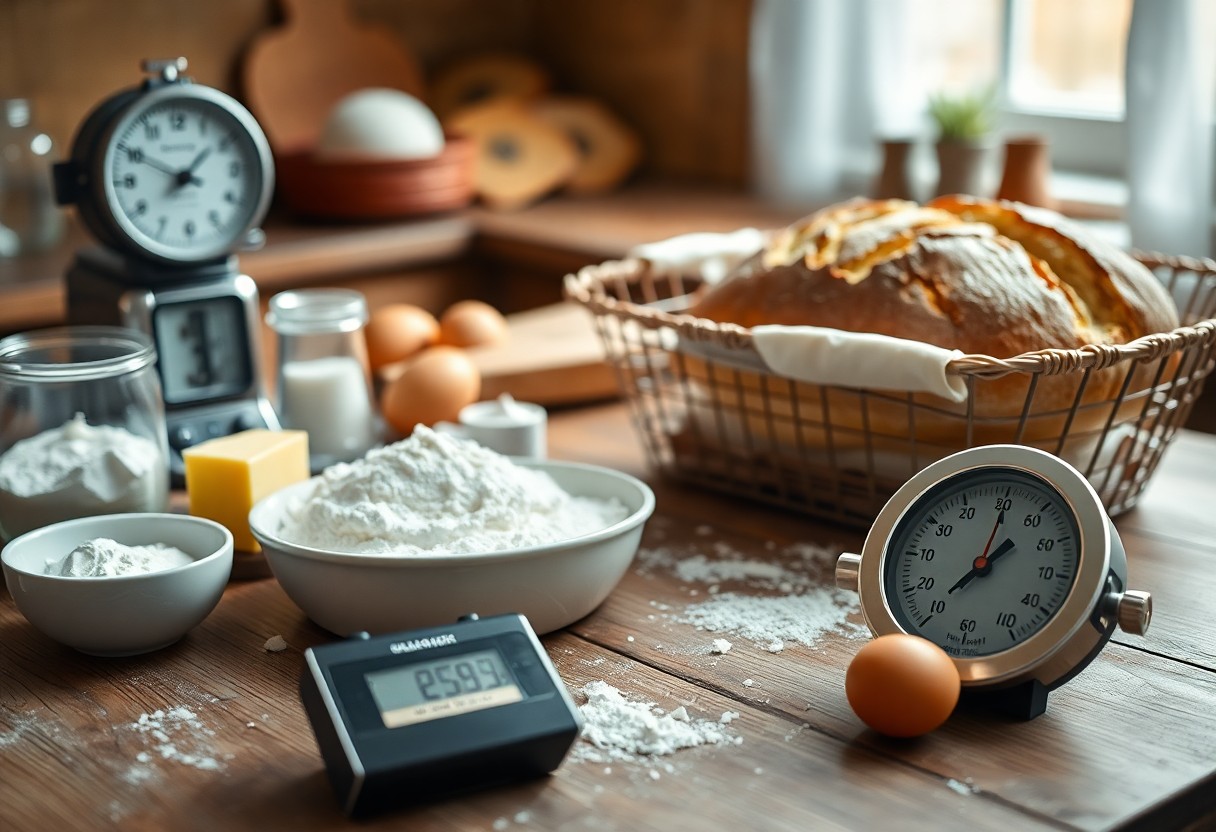Humidity can significantly affect your baking outcomes, influencing everything from texture to rise. Understanding how high humidity can lead to excess moisture in your ingredients can help you adjust your recipes effectively, preventing disasters like soggy breads or flat cakes. Conversely, low humidity may result in dry doughs that struggle to hold together. By paying attention to the humidity levels in your environment, you can fine-tune your techniques and ingredients, ensuring a consistently delightful baking experience that meets your expectations every time.
Key Takeaways:
- The moisture content in the air can significantly affect the texture and rise of baked goods, making it important to adjust ingredient ratios accordingly.
- High humidity can lead to dough absorption changes, which may require bakers to modify proofing times and baking temperatures for optimal results.

The Science of Water Vapor: How Humidity Affects Ingredients
Humidity plays an imperative role in the baking process, influencing the behavior of ingredients and their interactions. Water vapor present in the air interacts with dry ingredients, such as flour and sugar, affecting their moisture content and structural properties. In environments with high humidity, for instance, flour can absorb moisture from the air, which may lead to differences in dough consistency and hydration levels. Understanding how humidity alters ingredient dynamics can significantly impact the outcome of your baked goods.
The Role of Moisture in Flour and Dough Dynamics
Flour acts as a moisture reservoir, with its protein structure reliant on proper hydration to develop gluten. In humid conditions, flour can absorb excess moisture, resulting in a sticky dough that’s challenging to work with. Conversely, in drier environments, flour may retain less moisture, and you might need to adjust your liquid ingredients accordingly. Consistent moisture levels help achieve that perfect dough texture, enabling better rise and structure in your final bakes.
Yeast Behavior: Hydration and Fermentation Velocity
The relationship between yeast and moisture plays a vital role in fermentation. Yeast thrives in hydrated environments, where it quickly absorbs water, leading to activated growth and fermentation. In high humidity, yeast activity ramps up, promoting faster gas production and dough rise. This can lead to over-proofing if you don’t adjust your timing. On the other hand, in drier settings, yeast activity slows, potentially resulting in under-proofed dough. Balancing your dough hydration to match the humidity level may be the key to achieving perfectly risen and textured bread.
When yeast absorbs water during fermentation, it becomes more active, converting sugars into carbon dioxide gas and alcohol. In humid environments, fermentation velocity increases significantly, leading to a more vigorous rise. For instance, if you’re working with a sourdough starter on a humid day, you may notice that it doubles in size much quicker than expected—sometimes as little as one hour instead of the typical 2-3 hours. This rapid fermentation can result in a dough that expands too quickly, overwhelming its structure and causing deflation. Adjusting proofing times or dough handling becomes imperative to ensure that your baked goods maintain their desired texture and flavor.

Beyond the Oven: Humidity’s Influence on Baking Environment
The baking environment extends far beyond the oven’s confines. Factors such as room temperature, humidity levels, and even the altitude of your kitchen all play a vital role in how your baked goods will turn out. Humidity can alter the way ingredients interact even before they meet heat, affecting overall outcomes. For instance, a humid day may lead to excessive moisture absorption by flour and sugar, ultimately changing the consistency of your dough or batter and making all the difference in a recipe. Understanding this relationship is important for achieving the best results.
Temperature Interactions: Why Humidity Can’t Be Ignored
| High Humidity | Can lead to denser baked goods due to moisture absorption. |
| Low Humidity | May dry out your ingredients, requiring adjustments to recipes. |
The Impact on Baking Times and Textures
Humidity plays a significant role in determining both baking times and textures. High humidity can extend baking times as moisture needs to evaporate before the goods can properly set. Conversely, low humidity can lead to a quicker bake, which might result in drier textures. A classic example is bread; on a humid day, you may find that your loaf takes longer to develop a perfect crust compared to a dry day, where the outer layer crisps up sooner. Being aware of these nuances helps you adjust your approach to achieve the perfect bake every time.
Understanding how humidity influences baking times and textures allows you to tailor your methods for optimal results. For instance, during high humidity, it’s beneficial to monitor your bread’s internal temperature closely, ensuring it reaches around 190°F to achieve a fully baked loaf with a soft crumb and a golden crust. In contrast, with low humidity, you might consider adding a touch more water or steam to the oven to enhance the crust’s appearance and texture. These subtleties can make a significant difference in the final outcome, underscoring the need for adjustments based on your environment.
Troubleshooting Common Baking Disasters Linked to Humidity
Humidity can turn your baking dreams into nightmares if not accounted for. Dough can become overly sticky, cakes may sink in the middle, or cookies could spread too thinly. Observing your environment and recognizing how humidity influences recipes will help you navigate these disasters. For instance, if your bread dough feels too wet, adding a bit more flour can balance the mixture. Similarly, if your macarons are losing their shape, allowing them to dry out a little longer before baking can improve their structure and final appearance.
Adjusting Ingredients: Tactics for High-Humidity Success
High humidity can mean your ingredients absorb excess moisture, requiring adjustments. Increase your flour by a tablespoon or two to combat stickiness in batters and doughs, as wet air encourages ingredients to clump together. Using a bit more leavening agent in cakes can help them rise properly, countering the density added by humidity. Finally, mixing in a touch of cornstarch can help cookies retain their shape and avoid excessive spreading.
Best Practices for Low-Humidity Baking Conditions
Baking in low-humidity conditions poses its own challenges, like drying out your baked goods. Keeping your ingredients properly hydrated may require you to add extra liquid, especially in recipes like bread or cake. Ovens may dry out doughs swiftly, so vigilant monitoring is key. Consider using a pan of water in the oven or misting your goods with water before baking to prevent them from becoming too dry. Additionally, storing your baked items in airtight containers helps retain moisture for prolonged freshness.
In environments with low humidity, maintaining moisture becomes paramount. First, consider how quickly your ingredients can dry out; even flour can lose moisture if left uncovered for too long. When mixing dough or batter, closely observe the texture as it may need extra liquid to achieve a soft consistency. Incorporating ingredients like yogurt or sour cream adds moisture and flavor to cakes or cookies. Once baked, allow items to cool completely before wrapping, as trapping heat can create condensation and make them soggy, defeating your moisture-control efforts.
Humidity and Flavor Development: A Baker’s Secret Weapon
Flavor development in baking is often underestimated, but humidity plays a surprisingly pivotal role. Higher humidity levels enhance the hydration of ingredients, leading to an enriched Maillard reaction, responsible for browning and the creation of complex flavors in baked goods. As moisture increases, you unlock the potential for deeper caramelization, giving your bread or pastry a more robust and nuanced taste that captivates your palate. By harnessing the power of humidity, you can elevate your baking from simple to sensational.
How Water Affects Chemical Reactions During Baking
Water is a key player in the myriad of chemical reactions that take place during baking. It activates enzymes and gluten, facilitating dough development while also promoting crucial reactions like fermentation and browning. In a humid environment, the increased moisture allows for easier absorption by ingredients such as flour, enhancing the overall interaction among sugars, amino acids, and fats. Consequently, this relationship allows your baked goods to achieve richer flavors, better texture, and a more satisfying color.
Elevating Taste: Finding the Sweet Spot in Humidity Levels
Nailing the ideal humidity level can significantly amplify the taste of your baked goods. Too much moisture can lead to gummy textures, while too little leaves you with dryness and muted flavors. Aim for a balanced environment where the humidity levels are around 60%-70% for most baking scenarios, as this range promotes an optimal reaction between ingredients. Experimenting with specific recipes can help identify the sweet spot where flavor enhancement occurs without compromising texture, ultimately leading to bakery-style results in your kitchen.
Finding the sweet spot doesn’t just happen by chance; it requires observation and adaptation. For example, if you’re baking an enriched dough product, slightly higher humidity during the mixing stage can help dissolve sugars and enhance flavors in ingredients like butter and eggs. On the other hand, baking on a particularly humid day may call for slight adjustments in your ingredient ratios. Keeping notes on your results and adapting accordingly can turn your kitchen into a haven of delightful flavors, making each bake better than the last.
Seasonal Strategies: Adapting Baking Techniques Throughout the Year
Understanding how seasonal changes affect humidity allows you to fine-tune your baking techniques, leading to consistent results regardless of external conditions. In summer, when humidity levels peak, adjusting ingredient ratios can help combat excess moisture, leading to light and fluffy baked goods. Conversely, in winter, lower humidity calls for additional liquid in your recipes to prevent dryness. Observing local weather patterns as they shift through the seasons helps you anticipate necessary adjustments to your baking routine.
Tailoring Recipes to Seasonal Humidity Variations
Adjusting your recipes according to the season’s humidity is important for achieving the best results. In high humidity, you may need to reduce the liquid content slightly or add more dry ingredients, such as flour, to absorb extra moisture. Meanwhile, during dry months, adding a bit more moisture can make a significant difference in preventing crumbly textures. Making these small adaptations allows your baked goods to shine, showcasing their intended flavor and texture no matter the weather.
Essential Tools: Humidity Meters and Their Importance
Humidity meters, or hygrometers, are invaluable tools in your baking arsenal. These devices enable you to accurately measure the humidity levels in your kitchen, allowing for precise adjustments in your baking. By monitoring the environment, you can track changes throughout the day and season, ensuring that your ingredient ratios remain optimal for perfect baked goods.
For instance, consider investing in a digital humidity meter that provides real-time readings, often down to a single percentage point. This level of precision allows you to react quickly to fluctuating humidity waves, helping you adapt recipes on the fly. Regular use of a humidity meter can make a noticeable difference in the consistency of your results over time, aiding in the quest for baking perfection. Manufacturers even provide recommended adjustments based on humidity levels, enabling you to calibrate your baking approach without guesswork. With this important tool, you’ll navigate seasonal changes confidently and consistently produce outstanding creations.
Conclusion
Hence, understanding the hidden role of humidity in baking success can significantly enhance your culinary results. By adjusting your techniques and ingredient ratios according to the moisture levels in your environment, you can achieve the perfect texture and flavor in your baked goods. Embracing this knowledge will empower you to adapt your baking strategies, ensuring that you consistently create delicious treats, regardless of the atmospheric conditions. With practice and attention to detail, you will find that mastering humidity is a key ingredient in your baking repertoire.
FAQ
Q: How does humidity affect the texture of baked goods?
A: Humidity can significantly influence the texture of baked products. In high humidity, the increased moisture in the air can lead to a softer crumb and a more delicate structure in items like cakes and muffins. Conversely, in low humidity, baked goods may dry out faster, resulting in a denser texture and tougher crusts. Adjusting ingredient ratios or baking times based on humidity levels can help achieve the desired texture.
Q: What adjustments should I make to my recipes in high humidity conditions?
A: When baking in high humidity, consider reducing the amount of liquid added to your recipes, such as milk or water, to counteract the moisture in the air. For recipes that include flour, you might also want to increase the flour slightly to ensure proper absorption. Monitoring the dough or batter consistency is crucial; it should be just right, not too sticky or too dry.
Q: Can humidity affect the rise of doughs and batters?
A: Yes, humidity can impact how well doughs and batters rise. In humid conditions, the added moisture can cause yeast to activate more quickly, potentially leading to over-proofing if not monitored. This may result in doughs losing their structure. On the other hand, low humidity can result in slower fermentation processes, which might require longer proofing times. Adjusting proofing times and temperatures can help ensure the best rise and flavor.
Q: Is it necessary to adjust baking temperatures for different humidity levels?
A: Generally, baking temperatures do not need significant adjustments for humidity changes; however, it’s important to keep an eye on your baked goods as they may cook differently. For instance, in high humidity, you might need to extend baking times slightly. If your oven is fan-assisted, this can redistribute moisture and lead to a better outcome. It’s beneficial to use visual cues, like browning and texture, to determine doneness.
Q: How can I test humidity levels in my kitchen for baking?
A: To assess humidity levels in your kitchen, you can use a hygrometer, a device that measures moisture in the air. If you don’t have one, simple observations can help; for instance, if your flour feels clumpy, or if your dough is visibly wet, the humidity may be high. Some bakers even keep a small container of salt; if it clumps together, it indicates excess moisture in the air. Adjustments to your baking strategy can be made based on your findings.
